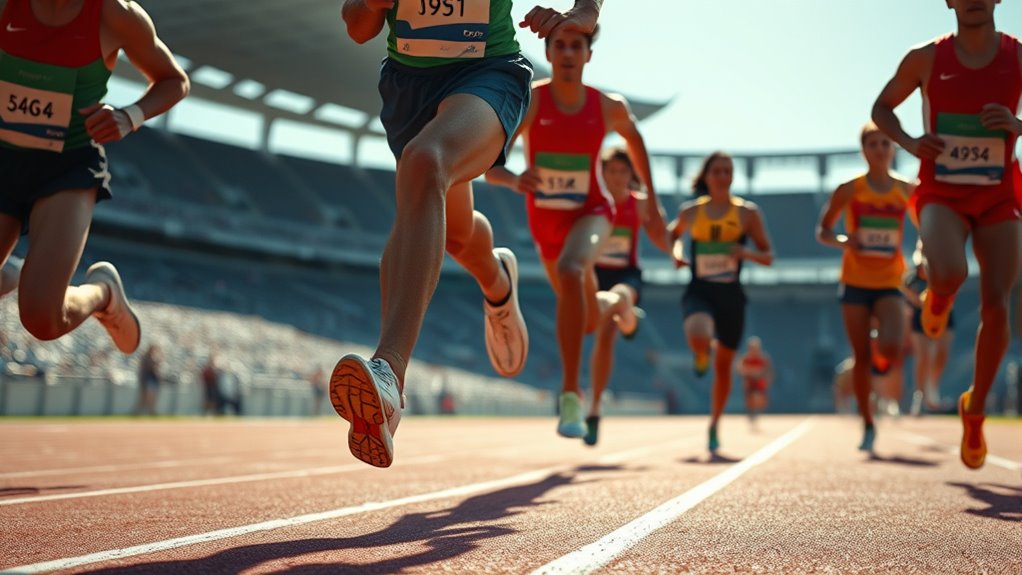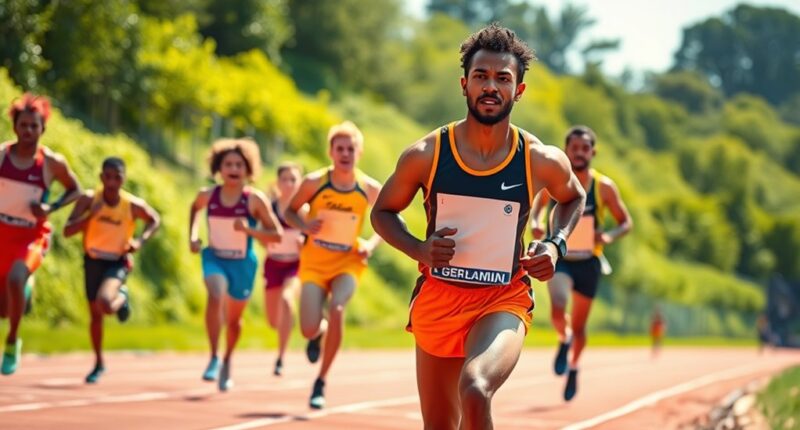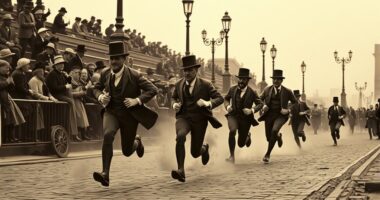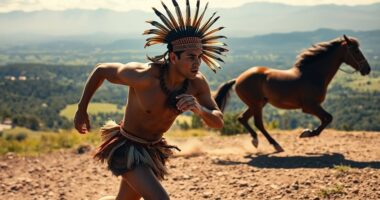You can discover how pioneering runners transformed the sport by embracing innovative training methods, personalized routines, and breakthrough footwear technology. Athletes like Steve Prefontaine and those in the Nike Oregon Project pushed limits with science-backed strategies and advanced shoes featuring carbon plates and lightweight materials. Their quest to maximize performance redefined what’s possible, turning running into a high-tech endeavor. Keep exploring to learn more about the athletes who broke barriers and reshaped running history.
Key Takeaways
- Pioneering training methods like interval training and altitude acclimatization revolutionized athlete performance.
- Innovators developed personalized, science-backed routines that minimized injuries and maximized efficiency.
- Advancements in footwear, including carbon fiber plates and lightweight materials, significantly boosted running speeds.
- Athletes and engineers embraced technology, transforming running into a high-tech, precision sport.
- Trailblazers challenged norms, inspiring broader participation and redefining what’s possible in running.

Throughout history, certain runners have revolutionized the sport by pushing boundaries and redefining what’s possible. Their achievements aren’t just about winning medals—they’re about inspiring change and transforming how athletes approach running. One of the most significant ways they’ve done this is through training breakthroughs. These athletes have pioneered new methods that optimize performance, from interval training to altitude acclimatization. By experimenting with training routines, rest periods, and nutrition, they’ve unveiled hidden potential and shown others that progress often comes from challenging traditional ideas. You see this in how marathon runners now incorporate high-intensity sessions or cross-training to boost endurance and speed, breaking old limits and setting new standards. Their innovations push everyone in the sport to think smarter about how they train, emphasizing quality over quantity and embracing science-backed strategies. Additionally, the development of specialized training techniques tailored to individual needs has allowed athletes to maximize efficiency and reduce injury risk, further transforming the sport. Footwear innovations also play a vital role in how these runners changed the sport. Over the decades, advancements in shoe technology have dramatically increased performance and reduced injury risk. You might recall how athletes like Steve Prefontaine and later, the Nike Oregon Project athletes, benefited from lighter, more responsive shoes. Today’s footwear innovations include carbon fiber plates, advanced foam materials, and biomechanically optimized designs that enhance propulsion and stability. These technological improvements allow you to run faster, longer, and more comfortably, often making the difference in record-breaking performances. The evolution of running shoes has turned footwear from a simple necessity into a performance-enhancing tool, empowering athletes at all levels to push past previous barriers. As runners continue to adopt new footwear innovations, they not only improve their own results but also pressure manufacturers to develop even better products, fueling a cycle of continuous improvement. These breakthroughs—whether in training techniques or shoe technology—highlight a core truth: progress in running isn’t just about natural talent or grit. It’s about embracing innovation and constantly seeking better ways to train, recover, and gear up. The runners who changed the sport understood this well. They experimented, challenged norms, and refused to accept limitations. Their willingness to adopt new ideas has transformed running from a simple form of exercise into a high-tech, precision sport. As you follow their lead, you see how pushing boundaries in training and footwear innovation can liberate your own potential, helping you reach new personal bests and inspiring others to do the same. These pioneers remind us that in running—just like in life—progress comes from daring to rethink what’s possible.
Frequently Asked Questions
What Are the Most Significant Technological Advancements in Running Gear?
You’ll notice that wearable technology and shoe innovation are the most significant advancements in running gear. Wearable tech like fitness trackers and smartwatches help you monitor your performance and stay motivated. Shoe innovation, including lightweight materials, cushioned soles, and energy-returning designs, boosts your efficiency and comfort. These technological improvements make running safer, more enjoyable, and help you push your limits, transforming the sport for everyone.
How Has Doping Affected the History of Competitive Running?
Doping has dramatically shaped competitive running, often acting like a double-edged sword that cuts into the sport’s integrity. You see, performance enhancement through banned substances skews results and raises serious ethical considerations, tarnishing the true spirit of achievement. While some athletes chase glory or records, doping undermines fairness, forcing us to question the legitimacy of victories and the sport’s future. It’s a controversy that’s forever etched into running’s history.
What Are Current Trends Shaping the Future of Marathon Training?
Today, you’ll see marathon training shaped by virtual coaching and nutrition optimization. Virtual coaching offers personalized plans and real-time feedback, making training more accessible and flexible. Meanwhile, nutrition strategies are becoming more scientifically driven, helping you improve endurance and recovery. These trends help you train smarter, stay motivated, and achieve your best marathon performance, all while adapting to your unique needs and schedule.
How Do Different Countries Influence Global Running Culture?
You might think running is universal, but different countries shape it uniquely through their running traditions and national running heroes. Ironically, countries like Kenya and Ethiopia, known for their long-distance legends, elevate running to a national pride, inspiring others worldwide. Meanwhile, Japan’s disciplined marathons and the US’s diverse running culture show how each nation’s stories and heroes influence global running culture, making it a rich, interconnected tapestry.
What Is the Impact of Social Media on Runner Motivation and Community?
Social media influence considerably boosts your runner motivation by providing instant access to inspiring stories, training tips, and success milestones. It encourages active runner community engagement, helping you connect with like-minded enthusiasts worldwide. By sharing your progress and challenges, you feel supported and accountable. This digital platform fosters camaraderie, pushes you to improve, and keeps your passion alive, making running a more social, motivating, and rewarding experience.
Conclusion
As you lace up and hit the track, remember these runners who rewrote history with every stride. They’re the sparks igniting a blazing trail, turning mere footsteps into legends. Their courage and innovation ripple through time, inspiring you to carve your own path. So, run not just to finish, but to leave your mark—because in the race of life, it’s the trailblazers who truly change the sport forever.









